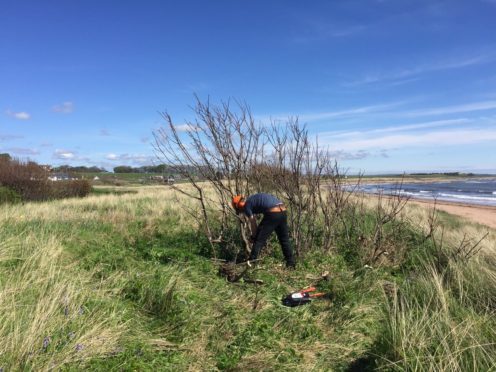Work to remove invasive species threatening a fragile Angus coastline is under way.
Invasive plant and animal species can cause dramatic and enduring changes to the geography and ecology of landscapes.
Wendy Murray from East Haven Together said: “We have to make sure that anything we do does not create a risk of damage by coastal erosion.
“Over the last few years a lot of evidence has emerged to show that soft natural defences such as marram and lyme grasses have been more effective than hard rock armour in protecting the coastline.
“In East Haven for example, we have been measuring the coastline from fixed points since 1990 and the coast line has actually accreted and not eroded.
“We therefore work hard to prevent any damage to the dunes and if accidental damage does occur we restore the dunes with marram and lyme.”
Work to remove invasive species from the Site of Special Scientific Interest (SSSI) in East Haven has been made possible thanks to a grant of almost £5,000 from Angus Environmental Trust.
During a community BioBlitz of 2016 it was identified that certain non-native species such as the snowberry were at risk of damaging the fragile eco-system of the dunes.
Non-native species also threaten the Greater Yellow-rattle which grows along the SSSI.
East Haven is the only place in Scotland where the Greater Yellow-rattle grows naturally.
The Greater Yellow-rattle is an annual wildflower native to temperate grasslands in much of Europe, and north and central Western Asia.
Following the BioBlitz, residents worked in partnership with Scottish Natural Heritage to explore options for removing and restoring the dune system.
This involved consideration of latex binders and other restorative initiatives but experts concluded that natural native grasses such as lyme, marram and festuca would be most effective.
As a result, hundreds of native grasses are currently being grown in small pots to plant in the main areas of work later in the year.
The issue of coastal erosion has been a significant concern in Angus, with experts and the local authority battling the problem for decades.










